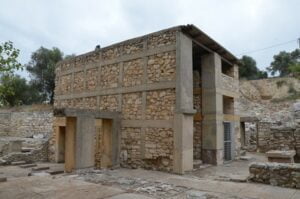
A Guide to the South Propylaeum in Knossos Palace
Are you planning a visit to the beautiful island of Crete? If so, then a trip to Knossos Archaeological Site is a must. This magnificent site, dating back over 3,000 years, is steeped in history and mythology. One of the most fascinating areas of the site is the South Propylaeum, a monumental structure that played a crucial role in ancient ceremonies and events. Join us as we delve into the secrets of the South Propylaeum and discover its importance to ancient Greek culture.
Table of Contents
South Propylaeum Location
The South Propylaeum is located at the south entrance of the Knossos Archaeological Site. This grand monument was the starting point of the painted procession that made its way to the palace at the heart of the site.
The procession, which was depicted in the famous frescoes discovered at the site, was a crucial part of ancient Cretan culture and took place during important ceremonies such as the New Year Festival.
The South Propylaeum was therefore a crucial structure in the social and political life of the ancient Cretans.
The South Propylaeum, like many of the structures at the site, has a problematic architectural sequence, making it difficult for visitors to understand how the structure was constructed. Sir Arthur Evans, the archaeologist who excavated the site in the early 1900s, proposed a reconstruction of the South Propylaeum, which gives visitors a better understanding of how the structure once looked. This reconstruction has been extremely beneficial to visitors and is a must-see when exploring the site.
Construction of South Propylaeum
SoThe South Propylaeum was constructed using a combination of giant limestone blocks and wooden beams, which were used to support the structure. These building materials and methods were typical of the time and can be seen in other structures at the site.
The construction of the South Propylaeum is a testimony to the skill and knowledge of the ancient Cretans, who managed to build such a magnificent structure without the use of modern tools and technology.
The West Wing
The West Wing, located just north of the South Propylaeum, is another important structure at the site. The upper floor of the West Wing was used as a grand entranceway to the palace and was an important part of the painted procession. The West Wing was also used for other important ceremonies and events, making it a crucial part of the ancient Cretan political and social scene. Visitors to the site can explore the upper floor of the West Wing and imagine what it must have been like to witness one of these ancient ceremonies.
Pithoi, large storage jars used for storing grains, wine, and oil, are another intriguing feature of the South Propylaeum. These pithoi were located on the north side of the South Propylaeum and played an important role in the economic life of the ancient Cretans.
These pithoi date back to the Post-palatial period and offer visitors a fascinating glimpse into ancient Cretan life.
The Sanctuary in South Propylaeum
The Greek Sanctuary, located on the site of the ruins of the South Propylaeum, is another important part of the site. This sanctuary was dedicated to Rhea, the mother of the gods in Greek mythology.
The sanctuary was built during the Hellenistic period and is a testament to the enduring significance of the site throughout the ages.
The South Propylaeum at Knossos Archaeological Site is a fascinating structure that offers visitors a glimpse into the heart of ancient Cretan culture. From its role in the painted procession to its construction using giant limestone blocks and wooden beams, the South Propylaeum is a testament to the skill and knowledge of the ancient Cretans. Visitors to the site can also explore the West Wing, the pithoi, and the Greek Sanctuary, all of which offer unique insights into the history and mythology of the site. So why not plan your visit today and explore the wonders of Knossos for yourself?
Sources – Further Research
- McEnrone, J. (2010). Architecture of Minoan Crete. University of Texas Press.
- Jarus, O. (2017). Knossos: Palace of the Minoans. https://www.livescience.com/27955-knossos-palace-of-the-minoans.html
- German, S. (2020). Knossos. https://www.khanacademy.org/humanities/ancient-art-civilizations/aegean-art1/minoan/a/knossos
- Ephorate of Antiquities of Heraklion – Knossos Scientific Committee. (2015). Knossos Documenta. https://knossosdocumenta.gr/en/the-palace-of-knossos/
- Gibson, G., Morden, M., Rowbotham, W. (2017). Odyssey Adventures in Archeology. https://www.odysseyadventures.ca/articles/knossos/articleKnossos03.approach.html










